|
|
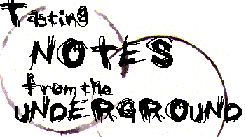 |
|
|
a 
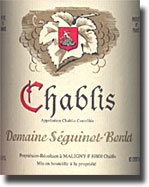 We
loved the
2000 Séguinot Bordet Chablis when we had it last year; in
fact we still have a few in the cellar from heck for future reference,
so when a stash of '99s turned up, we didn't hesitate to check them out,
and we really liked what we found. The same goes for the 2002 model, the
current vintage available here in Day-twah. Séguinot Bordet is one of
the oldest vignobles of Chablis, with vineyards that have been in the
family since the 1830s.
J et R Selections is the exclusive importer of
this estate for the US. We
loved the
2000 Séguinot Bordet Chablis when we had it last year; in
fact we still have a few in the cellar from heck for future reference,
so when a stash of '99s turned up, we didn't hesitate to check them out,
and we really liked what we found. The same goes for the 2002 model, the
current vintage available here in Day-twah. Séguinot Bordet is one of
the oldest vignobles of Chablis, with vineyards that have been in the
family since the 1830s.
J et R Selections is the exclusive importer of
this estate for the US. 1999 Domaine Séguinot Bordet Chablis, $17, 12.5% alc.: Medium straw, with soft wet stones, chalk and green apples dosed with more than a splash of lemon in both flavor and aroma; crisp and clean, with just the right amount of acidity and a long finish. Very nice with Kim's delicious chicken pot pie, and a wine that I could drink on a regular basis, winter, spring, summer or fall. A second bottle tasted showed an herbaceous quality and a little bees wax at the expense of some lemon, while the mineral took on a decidedly limestone character, but still, the wine was delicious, receiving positive comments all around among a group of friends. Great QPR; made with fruit from 25 year old vines. 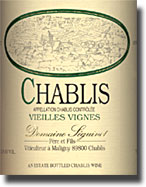 1999 Domaine Séguinot Bordet Chablis Vieilles Vignes, $19, 12.5% alc.:
Medium gold, with slate and flint on the nose, and little fruit to speak
of, but that's all right, because there's nice green apple and a splash
of lemon on the palate, with the flint and slate in support. Crisp,
clean, and still a bit tight at this point; certainly drinkable, and
even enjoyable, but it needs more time to show its best. Lots of
promise, so be patient; again, great QPR. Vinification is longer with
the Vieilles Vignes than with the regular Chablis, and the juice has
longer contact with the lees. It sees 7 - 10 days in steel, with
malolactic fermentation after 30 days. 1999 Domaine Séguinot Bordet Chablis Vieilles Vignes, $19, 12.5% alc.:
Medium gold, with slate and flint on the nose, and little fruit to speak
of, but that's all right, because there's nice green apple and a splash
of lemon on the palate, with the flint and slate in support. Crisp,
clean, and still a bit tight at this point; certainly drinkable, and
even enjoyable, but it needs more time to show its best. Lots of
promise, so be patient; again, great QPR. Vinification is longer with
the Vieilles Vignes than with the regular Chablis, and the juice has
longer contact with the lees. It sees 7 - 10 days in steel, with
malolactic fermentation after 30 days. 2002 Domaine Séguinot Bordet Chablis, $17.99, 12.5% alc: A medium straw, with flavors and aromas of wet stone, chalk, apple, pear, a little bees wax and some detergent on the finish. With good presence, density and zippy acidity, this is certainly drinkable now, and then some, but I'd like to come back to it in three to five years. And finally, from Chablis, we happened to run into this one from Joseph Drouhin a few months back, and we weren't going to pass up a Grand Cru bottling of any kind, much less Les Clos. 2002 Joseph Drouhin Chablis Les Clos, 13% alc.: Medium straw, with restrained green apple, pear, wet stones and little hints of citrus on the nose as it opens; flavors echo and expand nicely, blending fruit and mineral seamlessly, with zippy acidity and a nice finish. This makes a fine match for roasted chicken and root vegetables now, but would certainly benefit from some bottle age to develop some complexity and nuance. Rather well - behaved when compared to the others noted above, meaning I wouldn't mind more river stones and/or a little swamp water. Imported by Dreyfus, Ashby and Co., New York, NY 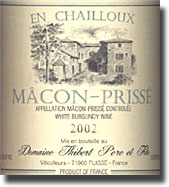 I first tasted
Domaine Thibert's Mâcon-Prissé "En Chailloux" with the
importer, J.C. Mathes of J et R Selections, and I loved it. So when
The Psychopomp (aka
Bill Schwab) rounded up the two latest vintages, we
didn't need any coaxing to give them a try. The two Thibert Pouillys
showed up on local retailers' shelves, and seemed like good bets to try
as well. I first tasted
Domaine Thibert's Mâcon-Prissé "En Chailloux" with the
importer, J.C. Mathes of J et R Selections, and I loved it. So when
The Psychopomp (aka
Bill Schwab) rounded up the two latest vintages, we
didn't need any coaxing to give them a try. The two Thibert Pouillys
showed up on local retailers' shelves, and seemed like good bets to try
as well.2001 Domaine Thibert Pere et Fils Mâcon-Prissé "En Chailloux," 13% alc.: Although this may not be quite as good as the 2000 version, it still drinks well and gives pleasure. Medium straw in color, with clean aromatics of apple, pear, cream, honey and rainwater, and big expressive flavors that echo with a hint of sweet cream soda over the decidedly dry base; The Psychopomp added his impression of "toasted vanilla." This has a nice density to it without being in any way heavy, and finishes with some stony minerality. From 10 year old vines, planted in soil containing more limestone than clay; the wine saw no oak, instead spending 6 to 7 months in stainless steel vats. 2002 Domaine Thibert Pere et Fils Mâcon-Prissé "En Chailloux," 13% alc.: No doubt reflecting the quality of the vintage, this is definitely a step up from the '01. A pale to medium straw in color, it gives plenty of rich, ripe apple and pear flavors and aromas, accented with a note of lime, a bed of mineral underneath it all and a hint of detergent on the finish. It shows good acidity and has a very nice presence. Kim exclaimed, "This is so pretty," and she was certainly right about that. 1999 Domaine Thibert Pouilly - Fuisse Vignes Blanches, $29, 13% alc.: This wine smells and tastes "yellow," and it looks that way too, with its pale golden color; it offers bees wax, mineral and a note of oxidation over some rich, tart apple and pear underneath it all on both the nose and palate. There's still plenty of acidity here, so the wine is in no danger of fading anytime soon, but while I find it interesting and even enjoyable, ultimately, it's just a little too maderized for my tastes; I probably would have liked it more a year or two ago. Or, perhaps it was an off - bottle, but someone else will have to crack one to test that theory. From 50+ year old vines in the best hectare of the appellation, aged 12 months on lees in 2 to 4 year old oak barrels. 1999 Domaine Thibert Pouilly - Vinzelles, $18.99, 13.5% alc.: Medium straw in color, with bees wax, tart green apple, mineral and a little quince in flavor and aroma; this has a rich, round mouth feel, adequate acidity and a nice, if not overly long finish. A nice match for the usual culinary suspects, such as fish and fowl dishes, or good just to sip on its own. Not quite up to Thibert's Mâcon-Prissé, but just fine on its own. Sourced from vines averaging 40 years of age, located on 1 hectare (2.4 acres) with southeast exposure on marly, clay-limestone soil, adjacent to the AOC Pouilly-Fuisse; fermented then aged in oak foudres for 8 months. Imported by J et R Selections, Mount Pleasant, MI 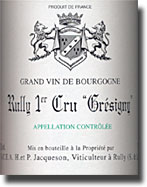 Our friend
Gary Kahle, of
Hand Picked Selections, has been telling us
for some time now how good Jacqueson's Rullys are, but this
is the first one we've tried, and it's a winner. Our friend
Gary Kahle, of
Hand Picked Selections, has been telling us
for some time now how good Jacqueson's Rullys are, but this
is the first one we've tried, and it's a winner.2001 H et P Jacqueson Rully "Grésigny," $29.99, 13% alc.: Kim really likes this medium gold colored Premier Cru from Rully, Jacqueson's flagship white, and so do I. It offers up flavors and aromas of tart apple and pear, accented with a streak of butterscotch, the sweeter aspects of which are diffused by an underlying base of minerality and an element of honeycomb - beeswax, all with subtle, creamy overtones of oak. Medium full bodied, with excellent intensity, lemon squirt acidity and good length on the finish, where a little something like detergent emerges. As nice as it is now, this has the structure to improve over the next three to five years. Imported by Hand Picked Selections, Warrenton, VA  Reporting from Day-twah, Reporting from Day-twah,
Bastardo |
||
|
Other Recent Wine Explorations Winemaker Profile: Whitney Fisher Giorgio Rivetti & the Wines of La Spinetta
Back to the
Underground
Index
|
||
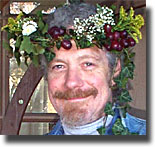

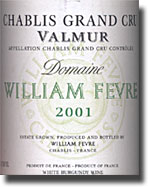 The more I drink the wines of Chablis, the more I like them. I'd been
eying these from William Fevre for a while, but kept hesitating because
of the price. Finally, curiosity got the better of me, and I went for a
couple of 375s. Fevre had been a tireless champion of Chablis,
particularly with regard to maintaining the traditional boundaries of
the appellation to include only vineyards located on the classic
Kimmeridgian rocks of that region, and to restricting the use of the
word 'Chablis' to describe only wines from, where else, Chablis. He
upgraded standards and practices, and expanded the domaine to become the
largest single holder of Grand Cru vineyards, as well as a significant
number of Premier Cru and regular Chablis sites. Then, in 1998, he sold
it all to Henriot Champagne, who in turn installed the winemaking team
from Bouchard P
The more I drink the wines of Chablis, the more I like them. I'd been
eying these from William Fevre for a while, but kept hesitating because
of the price. Finally, curiosity got the better of me, and I went for a
couple of 375s. Fevre had been a tireless champion of Chablis,
particularly with regard to maintaining the traditional boundaries of
the appellation to include only vineyards located on the classic
Kimmeridgian rocks of that region, and to restricting the use of the
word 'Chablis' to describe only wines from, where else, Chablis. He
upgraded standards and practices, and expanded the domaine to become the
largest single holder of Grand Cru vineyards, as well as a significant
number of Premier Cru and regular Chablis sites. Then, in 1998, he sold
it all to Henriot Champagne, who in turn installed the winemaking team
from Bouchard P